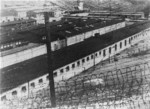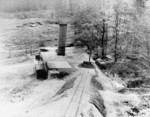Flossenbürg Concentration Camp
| Type | 254 Prison Camp | |
| Historical Name of Location | Flossenbürg, Bayreuth, Germany | |
| Coordinates | 49.735556000, 12.355833000 |
Contributor: C. Peter Chen
ww2dbaseIn early 1938, German efforts to arrest individuals deemed undesirable by the Nazi Party had increased. Intending to exploit these individuals, SS chief Heinrich Himmler ordered the establishment of a new slave labor camp to quarry granite, which was in high demand for building projects planned by the Nazi Party. Scouting for a location for this new camp began in Mar 1938 under Oswald Pohl and Theodor Eicke, and they decided upon the small rural town of Flossenbürg in southern Germany late that month, which was conveniently located near four existing blue-gray granite quarries. In Apr 1938, the SS established a new company, German Earth and Stone Works (DEST), which would operate the camp. The first transport, containing 100 prisoners, arrived on 3 May 1938, and these first prisoners participated in the construction of the camp as well as working in the quarries alongside of civilians. In the subsequent months, newly arrested prisoners and transfers from Dachau, Sachsenhausen, and Buchenwald camps increased the camp population to about 1,500 by the end of the year. Three quarries were operational by the end of 1938. In Apr 1939, Pohl gave the order to expand the camp so that it could hold 3,000 prisoners. 55 prisoners perished at the Flossenbürg Concentration Camp prior to the outbreak of the European War in Sep 1939. In late Aug 1939, several Flossenbürg prisoners were murdered by poison, dressed in Polish Army uniforms, and dumped on the Polish border as false evidence of Polish aggression in order to justify for the German invasion of Poland. During the first month of the war, 1,000 political prisoners were transferred from Dachau to Flossenbürg as Dachau temporarily became a training camp for Waffen-SS soldiers; these prisoners would return to Dachau in Mar 1940. In Apr 1940, Czech and Polish protestors, resistance fighters, and others arrested for anti-occupation activities in conquered foreign lands arrived at the camp. In May 1940, the construction of a crematorium was completed to handle the remains of those perished at the camp. In Apr 1941, the fourth quarry began operations. In mid-1941, Germany turned on its ally, the Soviet Union; as war raged on in the Russo-German war, Soviet prisoner population increased sharply at Flossenbürg. In early 1943, one of the four quarries was shut down in order to shift the labor power toward manufacturing. German aircraft manufacturing firm Messerschmitt was foremost among the firms that acquired slave labor from Flossenbürg, paying DEST 3 Reichsmarks per day for a skilled laborer and 1.5 Reichsmarks per day for an unskilled prisoner. Arado, another aircraft manufacturing firm, made use of Flossenbürg slave laborers as well. Prisoners were also used in synthetic oil production and railway repairs. At this time, about half the prisoners were working in quarries and half in war production. By the end of 1943, the camp employed about 450 German guards (both SS and non-SS personnel) and 140 Ukrainian auxiliaries. In early 1944, as war production quickly became DEST's most profitable enterprise, only about 1,000 prisoners were still working in the quarries at Flossenbürg. The prisoner population increased dramatically during 1944, and by the end of the year, the camp system (main camp plus subcamps) was housing 40,437 prisoners; the number of guards increased as well, to about 4,500 near the end of the war, which included 500 female SS personnel. As of 14 Apr 1945, the date which Himmler ordered all concentration camps to be evacuated, the prisoner population (including subcamps) was 45,800, 16,000 of which were women.
ww2dbaseThe first Flossenbürg subcamp was created in Feb 1942 at Stulln, Germany, about 50 kilometers to the south of Flossenbürg, providing forced laborers to a mining company which operates in southern Germany and in occupied Czechoslovakia. Starting from late 1943, in order to expand Germany's war production capabilities, Flossenbürg created 48 additional subcamps for that purpose. The most well-known subcamps of Flossenbürg included Johanngeorgenstadt, Hersbruck, and Leitmeritz.
ww2dbaseThe main Flossenbürg camp was liberated by the US Army on 23 Apr 1945. Its subcamps were liberated by both American and Soviet troops. Somewhere between 89,964 to 100,000 prisoners passed through Flossenbürg and its subcamps. Among them, about 30,000 died from malnutrition, disease, hypothermia, exhaustion, executions, and the forced marches out of the main camp and subcamps at the end of the war. About half of the deaths occurred at the main camp. About 10% of the total death occurred before 1943, 15% between 1943 and mid-1944, and 75% in the final nine months of the war (autumn 1944 to May 1945). Some of the administrators and guards were tried and convicted in the Flossenbürg trial. Out of the 52 charged, 40 would be found guilty. 15 of them received death sentences, 11 received life sentences, and 14 received prison terms of varying lengths; some of the sentences would later be reviewed and lessened. In 2007, the site became a memorial and museum.
ww2dbaseSource: Wikipedia
Last Major Update: Feb 2022
Flossenbürg Concentration Camp Interactive Map
Photographs
 |  |
Flossenbürg Concentration Camp Timeline
| 24 Mar 1938 | An SS commission chose Flossenbürg in southern Germany as the location of a new Nazi slave labor camp. |
| 31 Mar 1938 | The order for the construction of eight barracks at the Flossenbürg Concentration Camp in southern Germany was issued. |
| 3 May 1938 | The first transport, containing 100 prisoners, arrived at the newly established Flossenbürg Concentration Camp in southern Germany. |
| 9 May 1938 | A numbers of prisoners arrived at the newly established Flossenbürg Concentration Camp in southern Germany. |
| 16 May 1938 | A numbers of prisoners arrived at the newly established Flossenbürg Concentration Camp in southern Germany. On the same day, Heinrich Himmler and Oswald Pohl arrived at the camp for an inspection. |
| 23 Jan 1941 | 600 Polish prisoners arrived at Flossenbürg Concentration Camp from Auschwitz Concentration Camp in occupied Poland. |
| 6 Feb 1941 | Executions of prisoners by gunfire began at Flossenbürg Concentration Camp; the first victims were Polish political prisoners. |
| 8 Sep 1941 | 80 Polish prisoners were executed by gunfire at Flossenbürg Concentration Camp. After this execution, local civilians complained of blood contaminating local streams, and the method of execution at Flossenbürg would be switched to lethal injections. |
| 19 Oct 1942 | The last twelve surviving Jewish prisoners of Flossenbürg Concentration Camp were transferred to Auschwitz Concentration Camp in occupied Poland. |
| 5 Dec 1943 | A transport of 948 prisoners from Flossenbürg Concentration Camp arrived at Auschwitz Concentration Camp. More than 250 prisoners were already dead upon arrival. |
| 1 Jan 1944 | Petr Novikov was executived at the Flossenbürg Concentration Camp in Germany. |
| 9 Apr 1945 | Wilhelm Canaris was executed by hanging by piano wire at the Flossenbürg concentration camp in Flossenbürg, southern Germany. |
| 16 Apr 1945 | 1,700 Jewish prisoners at Flossenbürg Concentration Camp were loaded onto open freight railcars starting at 0500 hours, with very little food and water. When the train began to move out of the station, US aircraft strafed, killing an unknown number of prisoners. Those who were injured by the US attack were executed by SS guards. |
| 17 Apr 1945 | The evacuation of non-Jewish prisoners of Flossenbürg Concentration Camp began, with 2,000 prisoners being forced to march toward Dachau Concentration Camp in Germany on foot. |
| 19 Apr 1945 | 16,000 of the 25,000 to 30,000 prisoners still in the Flossenbürg Concentration Camp system were ordered to march toward Dachau Concentration Camp in Germany by rail and on foot. |
| 20 Apr 1945 | The train containing Jewish prisoners from Flossenbürg Concentration Camp was disabled by an US air attack. SS guards forced the 750 surviving prisoners out of the open freight cars, executed 140 prisoners who could not walk, and forced the remaining about 610 prisoners to march toward the Theresienstadt ghetto in occupied Czechoslovakia. |
| 23 Apr 1945 | A group of non-Jewish Flossenbürg Concentration Camp prisoners arrived at Dachau Concentration Camp in Germany after a six-day march. On the same day, troops of the US 90th Infantry Division liberated the main camp of Flossenbürg, finding 1,527 prisoners still in the camp; about 300 of them would die despite receiving care from US Army medics. Meanwhile, several groups of prisoners who were marched out of Flossenbürg in the preceding days were found and liberated by US Army troops in the surrounding area. |
| 3 May 1945 | US authorities held a funeral for 21 of the former prisoners of Flossenbürg Concentration Camp. |
| 6 May 1945 | Investigation of crimes at Flossenbürg Concentration Camp began, oversaw by 11 US Army appointed investigators. |
| 14 May 1946 | At the trials at Dachau Concentration Camp, the US charged SS-Hauptsturmführer Friedrich Becker (head of the labor department at Flossenbürg Concentration Camp), 33 low-ranking SS personnel, 16 prisoner functionaries, and 2 civilians for crimes committed at Flossenbürg Concentration Camp during the war. |
| 12 Jun 1946 | The Flossenbürg Trials at Dachau Concentration Camp began. |
| 22 Jan 1947 | The Flossenbürg Trials at Dachau Concentration Camp ended. Of the 52 charged, charges were dropped for 7, 5 were found not guilty, and 40 were found guilty. 15 received death sentences, 11 received life sentences, and 14 received prison terms. |
Please consider supporting us on Patreon. Even $1 per month will go a long way! Thank you. Please help us spread the word: Stay updated with WW2DB: |

Flossenbürg, Bayreuth, Germany
Latitude-Longitude:
49.7356, 12.3558
 |  |
- » 1,179 biographies
- » 337 events
- » 45,089 timeline entries
- » 1,245 ships
- » 350 aircraft models
- » 207 vehicle models
- » 376 weapon models
- » 123 historical documents
- » 261 facilities
- » 470 book reviews
- » 28,479 photos
- » 365 maps
Lt. Gen. Lewis B. "Chesty" Puller, at Guadalcanal